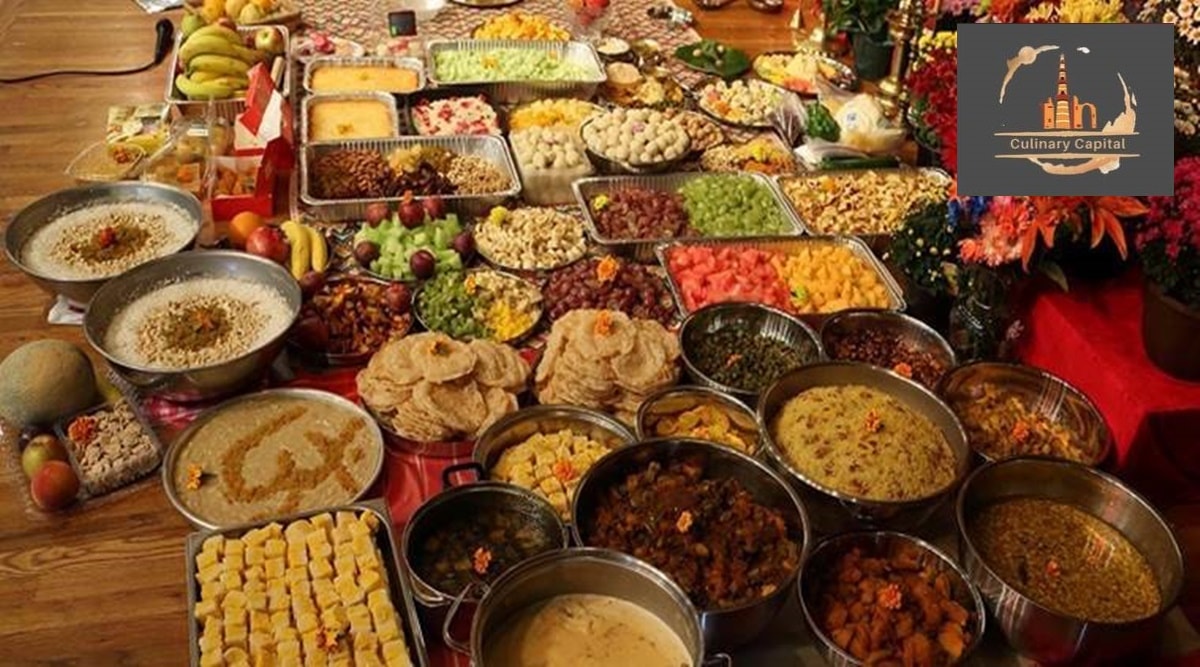 Nutritionists may tell you that the khichdi-labra-chutney is the best thali meal there is, complete with plant protein, carbohydrates and fibre, the nutrients spread evenly (Source: File Photo)
Nutritionists may tell you that the khichdi-labra-chutney is the best thali meal there is, complete with plant protein, carbohydrates and fibre, the nutrients spread evenly (Source: File Photo)“Why doesn’t everyday food taste like this?” This is a common question that gets asked by everybody who has had the classic Durga Puja bhog of khichdi, labra (a mish mash of seasonal greens) and chutney. That comforting fullness of the khichdi is complemented by the runny, slurpy and oozing mix of vegetables whose juices just soak up each other, leaving a deeply satisfying and absorbing aftertaste. The chutney is a relish to the entire spectrum of flavours. And yet all it needs is a simple toss-up of leafy greens, stalks, plantain, brinjal, sweet pumpkin in a ghee or oil tempered with red chilli and paanch phoran (our version of a five-spice mix). Then it is spiked up with ginger and seasoned with salt, sugar, a pinch of turmeric, red chilli and cumin powder. Cover the pot with a lid, forget it and wait for the flavours and aroma to waft up your senses and tell you it is done. Nutritionists may tell you that the khichdi-labra-chutney is the best thali meal there is, complete with plant protein, carbohydrates and fibre, the nutrients spread evenly. But as chef Sabyasachi Gorai will tell you, “The best part of the Durga Puja bhog is that nobody realises that healthy food can be the tastiest. And yet the bhog is the greatest example of a one-pot meal with seasonal produce that’s stewed in its juices and cooked without additives. Often cooks would throw in what they had in their kitchen in the most practical way possible. And the goulash would always magically taste good. There is no leakage of minerals. And traditionally it was made in earthen pots over clay ovens, which gave it an earthy wholesomeness. And it is this simplicity that’s difficult to recreate in our modern kitchens.” He has been trying to recreate the authentic flavours of the bhog at many cookouts the traditional way. “Often doing the simplest things seems most complex,” he adds.
The Durga puja bhog had plebeian origins, often associated with Sri Chaitanya Mahaprabhu, a Vaishanavite saint of the 15th century, who ate the food of the common people. In fact, it was during the Bengal famine of 1943 when the prosperous Bhattacharjee family of Howrah began distributing bhog to the people as part of their Durga Puja, a mix of banana stems and green amaranth. From then on, the distribution of bhog was seen as a community service by the big zamindars. Then came the East India Company and the pujas became political, with the babus, merchants and zamindars eager to please the British with feasting and cultural soirees. That was the beginning of the community puja as we know it today. “The dishes started getting more complex and lavish,” adds Gorai. There would be pulaos, fritters, sweets and even fish and mutton curries on the ninth and tenth day of the pujas, more as a showcase of Bengal’s culinary heritage and a celebration of the local produce. “However, use of garlic and onions is strictly prohibited in puja dishes, even for fish or mutton curries,” says Gorai. For example, the bhog mutton curry is cooked with pepper, cumin powder and ginger paste as the predominant spices. Some families had panta bhaat (or fermented rice) with other accompaniments on Vijaya Dashami as a smart way to use up leftovers. At the house of Sabarna Roy Choudhury, the zamindar who sold off territorial rights to the British, the offering to the goddess was rich, complete with fish head, fish cooked with mustard sauce or as a curry. Of course, the bhog fish would be roasted. And then there was the Kosha Maangsho, not a bhog but a post-fasting indulgence. Mutton was slow-cooked with hand-ground and whole spices, onion and garlic, stirred and stirred in mustard oil till the fat separated from the meat and sizzled it up further, the fibres so tenderised that they would melt in the mouth with those fluffy and flaky white flour breads called luchi. The longer it is stirred and cooked over a slow fire, the better the layers of flavour. Also, salt is not added to the curd-based spice marinade as otherwise the meat would release water, dulling out the taste. In fact, the post-fasting celebration allowed for more experimentation and indulgence. Post the 70s, the dominant home puja spilled over into community parks and clubs. And with commercialisation, Kolkata street food was legitimised like never before, chops, cutlets, chowmein and Mughlai rolls dominating the “food-on-the-go” platters at specially set up food stalls as families and youngsters hopped from one puja pandal to another. Today, the Durga Puja is unimaginable without its many food stalls. So much so that it has birthed a new stall culture, one that is not just confined to food but everything aspirational. And we have been spoilt for choices. Except the bhog reminds you why we should go back to the basics.